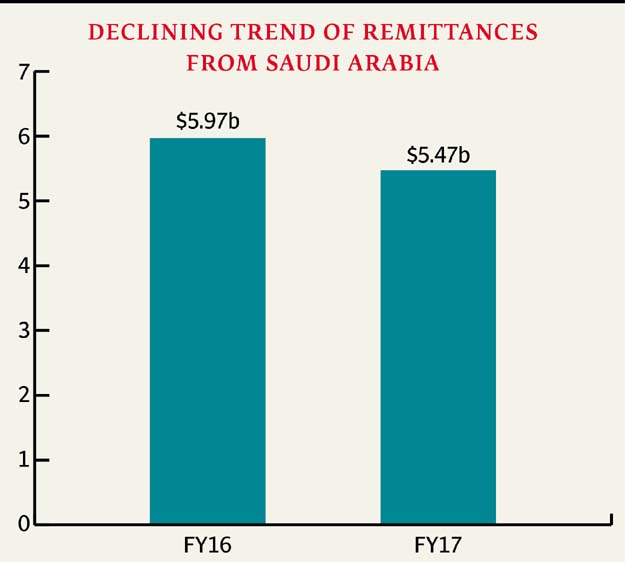
During the last month of FY17 in June the inflow of remittances amounted to $1.84 billion, down 11.2% compared with $2.07 billion in June 2016.
Despite the overall decline in remittances in FY17, the situation is not as alarming for policymakers when seen in the context of a 20% drop during the first month of the fiscal year (July’16).
World Bank expects Pakistan's economy to grow 5.2%, but risks remain
The sudden drop in remittances right at the start of the fiscal year had prompted growing concerns about a balance of payments crisis amongst analysts and economic experts.
An economic crisis in Gulf countries - the major sources of employment for overseas Pakistanis contributing 63% of Pakistan’s earnings from remittances- due to reduced crude oil prices and a global economic slowdown have been the major causes of reduced remittances.

Saudi Arabia still tops the list
The flow of remittances coming from Saudi Arabia - the country that hosts the largest Pakistani diaspora (about 2 million) - has reduced significantly by 8.4%, from $5.97 billion in FY16 to $5.47 billion during FY17.
The oil-rich kingdom has deported thousands of Pakistanis in the past few months amid slowdown in its economy due to low oil prices and growing security concerns.
Experts had earlier warned that low crude oil prices will eventually hurt Pakistan’s remittances due to economic slowdown in the Gulf countries resulting in massive layoffs for foreign workers.
The other notable decline was seen in remittances coming from the UK which declined by 9.36%, from $2.58 billion to $2.34 billion in FY17. Analysts blame the shocking withdrawal of UK from the European Union (EU) in June 2016 which resulted in the British pound losing its value against the rupee, thereby hurting the dollar value of remittances rather than their volume.
The lowest decline was witnessed in remittances coming from the UAE and the US - the other top two destinations for overseas Pakistanis. The country received $4.31 billion from the UAE in FY17, down just 1.27% from $4.36 in the last year. Similarly, $2.44 billion came from the US in FY17, down 3.22% from $2.52 billion in FY16.
Moody's says Pakistan's external debt will increase to $79 billion
Moreover, the country received $2.42 billion from GCC countries, excluding Saudi Arabia and the UAE, in FY17, down 4% from $2.32 billion in the FY16.
Gainers
Despite the global economic slowdown, remittances coming from EU countries are continuously increasing which augurs well for Pakistan.
In FY17, Pakistan received $483 million from EU countries, up 15.5% compared with $418 million in FY16. In FY15, remittances from the EU had witnessed a jump of 14.7% as well.
All other major countries including Norway, Switzerland, Australia, Canada and Japan also showed a significant jump in FY17 compared with last year. Other Countries, excluding major economies also showed sizeable increase of 22% from $1.19 billion to $1.46 billion.
Published in The Express Tribune, July 11th, 2017.
Like Business on Facebook, follow @TribuneBiz on Twitter to stay informed and join in the conversation.
1672385156-0/Andrew-Tate-(1)1672385156-0-405x300.webp)
















COMMENTS
Comments are moderated and generally will be posted if they are on-topic and not abusive.
For more information, please see our Comments FAQ